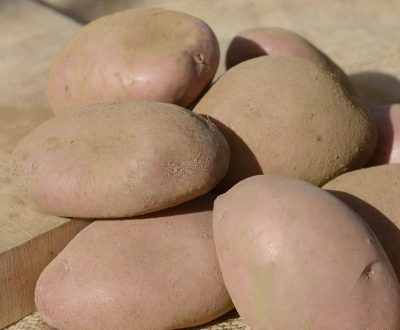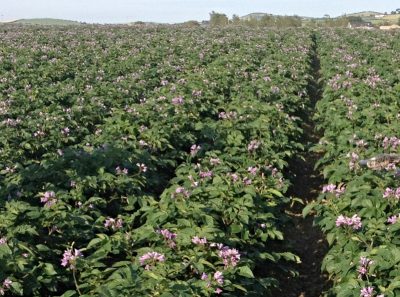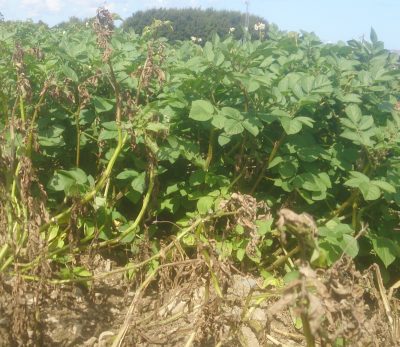PARENTAGE
The parents of Sarpo Axona are trial varieties which have never been released to the public. For the technical minded they are 76PO1214268 and D187.
APPEARANCE, TASTE AND CHARACTERISTICS OF SARPO AXONA
Sarpo Axona Potatoes (click to enlarge)
The potatoes have a skin colour which ranges from dull brown to slightly rusty-red. They tend to have a slightly rough texture all over. The skin is thicker than average but it has few eyes. The size varies significantly; from the same plant you will get large baking potatoes and also much smaller potatoes and probably every size in between. The retail trade don’t like this but for the average cook it’s quite convenient to have a choice of sizes.
Sarpo Axona is most definitely only a maincrop potato and it produces the largest potatoes a couple of weeks later than most other maincrops. Like most maincrops they have a floury, rather than a waxy texture, so they are not very good for boiling.
The reason is, floury potatoes absorb water far quicker than waxy potatoes. This causes the outside of the potato to become “watery” before the centre has fully cooked through. Microwaving is one option which works for many instead of boiling. This variety stores exceptionally well; in correct conditions many will still be edible four months or more after harvest.
The plants themselves grow slightly taller and quicker compared to most other varieties, so much so that weeds simply don’t stand a chance. The dense foliage also has the benefit of excluding almost all light from potatoes growing near the surface – this prevents them turning green. We wouldn’t grow them in very windy conditions because they are liable to to be blown over.
Foliage and flowers of Sarpo Axona
Wind damage can be dealt with, apparently, by simply cutting away any fallen foliage. Sarpo Axona potato plants are so vigorous that they simply sprout new foliage and continue growing. Disease resistance is excellent, especially to blight of the tubers and foliage. See more specific details later in this article here.
POSITIVE POINTS FOR SARPO AXONA
High resistance to all forms of blight, good taste, reliable variety producing good crop levels late in the season.
NEGATIVE POINTS FOR SARPO AXONA
A few have found that the texture was slightly more floury than they would prefer, although others prefer the fuller texture. To reduce the floury texture, harvest the potatoes a couple of weeks earlier than normal. See the section on harvesting dates for more information.
BUYING SARPO AXONA SEED POTATOES
Sarpo Axona has now become a relatively common variety of potato which is readily available online and sometimes in garden centres. The company which markets them and has breeders rights ensures that prices for this variety of potato are slightly higher than other varieties.
We recommend buying your seed potatoes from certified suppliers because those sold in supermarkets for consumption can be a source of disease and pest. We would avoid buying them from online general retailers such as as Amazon or E-bay unless you know exactly who is supplying the seed potatoes.
Buying seed potatoes from the discount store can be a good deal but it can also result in a sub-standard crop. The discount stores take the second quality seed potatoes whereas the more specialist suppliers take the best quality. Unfortunately you will only find this out after you have carefully tended your crop for several months.
ALTERNATIVES TO SARPO AXONA POTATOES
The two primary qualities of this variety are excellent blight resistance and large crops of good tasting potatoes. The first alternate variety to recommend would be the “sister” variety Sarpo Mira (awaiting review results) which has many of the same qualities although it grows even taller making it liable to wind damage. The second highly blight resistant variety which we would recommend is the Irish bred Setanta.
For other potato varieties which we have fully reviewed, click the drop down box below, select a variety and then click the More Information Button.
The planting and harvest dates used below are correct for the UK average. If you want them to be even more accurate and adjusted for your area of the UK click here. It only takes a minute and the adjustment affects every date in this site and lasts for six months.
WHEN TO CHIT / SPROUT SARPO AXONA POTATOES
We recommend that you start chitting / sprouting Sarpo Axona potatoes in the third week of February This will give them four to five weeks to develop healthy sprouts just at the time when they are ready to be planted out. Keep the potatoes in cool but light conditions to ensure they grow short, green sprouts. Click here for our page dedicated to chitting / sprouting potatoes in the UK and Ireland.
WHEN TO PLANT SARPO AXONA POTATOES
Sarpo Axona potatoes are a late maincrop variety of potato and they are ready for harvest, if conditions are correct, approximately 20 weeks after the seed potatoes are planted. The key factor governing the time for planting all potatoes is the date of the last frost in your area. Even a touch of frost can damage potato plants if their foliage is above ground, an unexpected severe frost can kill them completely.
The date for planting Sarpo Axona potato seed can be calculated on the basis that seed potatoes will take four weeks before they appear above ground. Given also that you want them to appear above ground only when the danger of frost has passed (the last week of April is the UK average ) the last week of March is about right time to plant them. If you miss this date, planting them up to a month later will still result in an acceptable crop.
WHEN TO HARVEST SARPO AXONA POTATOES
The harvest date for all potatoes is not only dependent on when you plant your seed potatoes, it also depends on the weather conditions throughout the growing season. But on average you can expect your potatoes to be ready for harvest some time between the second and last weeks of August 2017 in your area of the UK.
This maincrop variety can be left in the ground longer than the normal 18 to 20 weeks and it will increase in size for four weeks or so, growing strongly into November in many areas of the UK. It will become more floury by the week, but it still makes a very good potato.
PEST AND DISEASE RESISTANCE OF SARPO AXONA
The table below sets out how good or bad this variety is at resisting common pests and diseases in the UK. The 0 point is average with minus (red) values showing lower than average resistance and plus values (green) showing higher than average resistance.
| -5 | -4 | -3 | -2 | -1 | 0 | +1 | +2 | +3 | +4 | +5 | |
| Late blight – foliage |
|||||||||||
| Late blight – tubers |
|||||||||||
| Common scab |
|||||||||||
| Powdery scab |
|||||||||||
| Slugs |
|||||||||||
| Potato Cyst Nematode (pallida) |
|||||||||||
| Potato Cyst Nematode (rostochiensis) |
|||||||||||
| Blackleg |
|||||||||||
| Splitting |
|||||||||||
| -5 | -4 | -3 | -2 | -1 | 0 | +1 | +2 | +3 | +4 | +5 |
The picture above shows a healthy crop of Sarpo Axona next to a crop of Maris Piper which has been decimated by blight.
SUMMARY CHARACTERISTICS OF SARPO AXONA
TYPE: Late Maincrop
USE: Good for roasting, chips, saute, baked
SKIN COLOUR / TEXTURE: Light red-brown, thick skinned
FLESH COLOUR: Cream to yellow
TASTE AND TEXTURE: Good taste, floury texture
STORAGE: Four months
POTATO SIZE: Medium to large, variable.
REGULARITY OF CROPPING: Regularly produces a good yield
AWARDS: None
SPECIAL FEATURES: Excellent resistance to all forms of blight



How to Grow Potatoes
Recommended Varieties
How to Chit / Sprout
Planting Seed Potatoes
Caring for Potatoes
Harvesting and Storing
Potatoes in Containers
Pest and Disease
SARPO AXONA POTATO
Sarpo is very modern potato variety, first being released for sale in 2004. It was bred by Dr Sarvari in Hungary specifically for resistance to blight.
In 2013 Sarpo Potatoes Ltd was set up specifically to market the potatoes not only in the UK but all over the world.
The name “Sarpo” is an abbreviation of “Sarvari” and “potato”. The first of the Sarpo potato varieties was Mira, followed a couple of years later by Axona. The consensus is that both are highly resistant to blight and that Axona has the best flavour of the two.